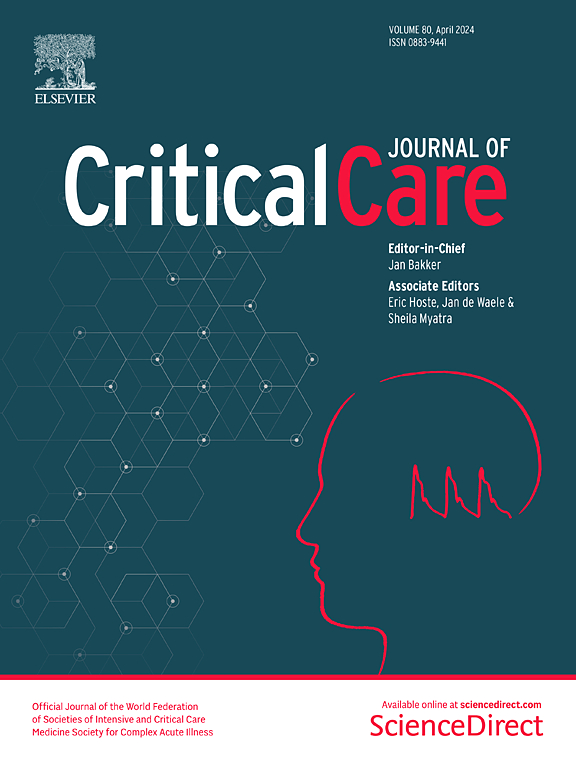Advanced serial analysis of the diaphragm surface EMG: insights into the effect of pressure support on the neuro-ventilatory response during the ICU stay
IF 8.8
1区 医学
Q1 CRITICAL CARE MEDICINE
引用次数: 0
Abstract
Ventilatory support levels in ICU patients should be tailored to both optimal gas exchange and respiratory muscle loading, as over- and underassistance may cause diaphragm dysfunction. The diaphragm’s capacity to overcome mechanical load and deliver ventilatory output is reflected by the patient’s neural respiratory drive (NRD), tidal volume (TV) and respiratory rate (RR). Surface electromyography of the diaphragm (sEMGdi) offers a continuous, non-invasive measure of NRD. We investigated the effect of pressure support (PS) level on the coupling of diaphragm electrical activity (sEAdi) and ventilatory output during the ICU stay. In clinically stable ICU patients (N = 17), four PS-levels were applied on alternate days, based on the clinical value (− 3, + 0, + 3, and + 6 cmH2O). sEAdi time-product (ETPdi) was calculated from high-quality sEAdi waveforms, using a novel, advanced signal analysis approach. The breath-by-breath correlation between ETPdi and TV was defined as neuro-ventilatory coupling (NVC), enabling quantification of the neuro-ventilatory response. On group level (13 patients, 26 PS-trials), ETPdi and RR increased with decreasing PS-levels (2.4 and 1.6 percentage point (pp)/cmH2O), whereas TV decreased (2.5 pp/cmH2O). Longitudinal analysis (4 patients, 14 PS-trials) showed strengthened coupling between ETPdi and TV during weaning, reflected by an increase in median NVC from 3.4% (IQR 2.9) to 26.3% (IQR 21.7) between the first and last PS-trial. Advanced sEMGdi analysis allows for non-invasive quantification of NVC, reflecting the diaphragm’s capacity to overcome mechanical load. In patients approaching liberation from MV, increasing NVC indicates the shift from near-passive to active breathing. This study demonstrates the potential of NVC to inform tailoring of ventilatory support levels. Trial registration number: Dutch Trial Register NL9654. Registered August 05, 2021.膈肌表面肌电图的高级系列分析:了解ICU住院期间压力支持对神经通气反应的影响
ICU患者的通气支持水平应根据最佳气体交换和呼吸肌负荷进行调整,因为辅助过度和辅助不足可能导致隔膜功能障碍。膈膜克服机械负荷和输送通气输出的能力通过患者的神经呼吸驱动(NRD)、潮气量(TV)和呼吸速率(RR)来反映。膈肌表面肌电图(sEMGdi)提供了一种连续的、无创的NRD测量方法。我们研究了压力支持(PS)水平对ICU住院期间隔膜电活动(sEAdi)和通气量耦合的影响。在临床稳定的ICU患者(N = 17)中,根据临床值(−3、+ 0、+ 3和+ 6 cmH2O)隔天应用4个ps水平。sEAdi时间积(ETPdi)是利用一种新颖、先进的信号分析方法从高质量的sEAdi波形中计算出来的。ETPdi与TV的逐呼吸相关性被定义为神经-通气耦合(NVC),从而可以量化神经-通气反应。在组水平上(13例患者,26项ps试验),ETPdi和RR随着ps水平的降低而升高(2.4和1.6个百分点(pp)/cmH2O),而TV下降(2.5 pp/cmH2O)。纵向分析(4例患者,14项ps试验)显示,断奶期间ETPdi和TV之间的耦合增强,反映在第一次和最后一次ps试验之间的中位NVC从3.4% (IQR 2.9)增加到26.3% (IQR 21.7)。先进的sEMGdi分析允许非侵入性量化NVC,反映隔膜克服机械负荷的能力。在接近中压释放的患者中,NVC的增加表明从近被动呼吸转向主动呼吸。这项研究证明了NVC在通气支持水平的定制方面的潜力。试验注册号:荷兰试验注册号NL9654。注册于2021年8月5日。
本文章由计算机程序翻译,如有差异,请以英文原文为准。
求助全文
约1分钟内获得全文
求助全文
来源期刊

Critical Care
医学-危重病医学
CiteScore
20.60
自引率
3.30%
发文量
348
审稿时长
1.5 months
期刊介绍:
Critical Care is an esteemed international medical journal that undergoes a rigorous peer-review process to maintain its high quality standards. Its primary objective is to enhance the healthcare services offered to critically ill patients. To achieve this, the journal focuses on gathering, exchanging, disseminating, and endorsing evidence-based information that is highly relevant to intensivists. By doing so, Critical Care seeks to provide a thorough and inclusive examination of the intensive care field.
 求助内容:
求助内容: 应助结果提醒方式:
应助结果提醒方式:


